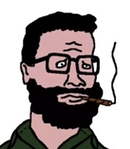(Don’t know why it’s sideways.)
We all know American intro to politics textbooks are garbage, but this graph was really funny to me. This is obviously just a rebranded horseshoe theory, but the author makes it very clear that this graph is special because it’s about relative political attitudes, NOT ideology (don’t worry he’s got a bespoke ideology cumpiss too). As if you can remove ideology and still maintain any representation of real world politics.
Basically, this dude legitimizes his theory by arguing that radicals and reactionaries are similar because they both use violence, despite having different goals. Liberals and conservatives, on the other hand, are notorious for never using violence, and have never supported the police or started wars that have killed millions of people. That violence isn’t real because the state says it’s good.
The creme de la creme comes on the next page though, where he shoehorns his horseshoe theory onto other countries. According to him, Xi Jinping is a conservative, Maoists are reactionary rather than Ultras (arguably true but that’s from our perspective), liberals want more capitalist reform (objectively correct, but for the wrong reason), and the real radicals are the ones that want Taiwan to invade.
Overall, 3/10. I feel like I need to learn Chinese to read a good textbook.


deleted by creator
The author defines reactionary as wanting to revert to some historic ideal, in this case Maoist China without market reforms
deleted by creator
It’s supposed to be for comparing different ideologies within different countries, but in order to do so you remove all ideology. This means that Maoist’s in China can be reactionary while maoists in the Philippines can be radical, despite having the same ideology.
deleted by creator
I mean if you want to get really technical China’s biggest study of socialism is Mao Zedong Thought, which includes everyone up to Mao, as well as many other Chinese revolutionaries and philosophers.
deleted by creator